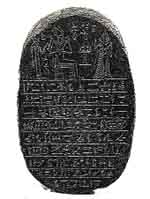WritingEarly KushiteSteles, dating to 1600 BC, were found in Kerma. Although it is unlikely that the steles were used for anything other than writing, their bad conditions did not allow the survival of carved inscriptions. Evidence for other writings at Kerma, would have likely been destroyed during the Egyptian intrusion of the sixteenth century BC. After all, it was the habit of the Egyptian kings to erase writings and destroy evidence that pertain to their enemies. Hence, it wouldn't be appropriate to make solid conclusions on the literacy of the Kerma people.
The traditional scholarliy perspective, which maintained that the Kushites borrowed their hieroglyphic writing system from the Egyptians during the New Kingdom, is now considered to be outdated. Recent research showed that the historical reality of hieroglyphics in Sudan is much more complicated. Recent diggings lead to the discovery of hieroglyphs in Kush that date to periods before the New Kingdom and the Egyptian incursions of the sixteenth century BC.1 Further, the hieroglyphs were local in nature. The larger part of discovered writings from Kush date to after the sixth century BC. Writings were found in Napatan constructions built of durable materials, such as backed bricks and sandstone. The durable walls, as well as the steles that were kept safe within temple and palace areas, were carved and painted extensively with inscriptions. The writing system in Kush was generally the same as that of the ancient Egyptians; the common writing systems were hieroglyphic, hieratic, and demotic. Hieroglyphs were used most commonly on walls due to their visually appealing representational nature. They were carefully outlined, carved, and painted with bright colors. Written either horizontally or vertically, the signs are oftten composed of figures easily recognizable to the human eye such as an eagle, a snake, or some animal. The horizonal orientation of the signs, whether written from left to right, or the vise versa, was determined by the direction that the representational figures of the signs face. In its vertical orientation, the script was witten from top to bottom; whether they were read from left to right, or the vise versa, was also determined by the direction of the representational figures. The hieroglyphs can be divided into three basic elements: • A phonogram in which a sign is used to represent one or more sounds. • A word-sign, or a direct visual representation of a certain object or an idea. This type of sign is declared to the reader by a single subsequent stroke. • A determinative in which a sign is used to explain to the reader the meaning of preceeding signs. Due to their complex and elaborate shapes, hieroglyphs were not practical for everyday communication. Drawing the shapes was time consuming and demanded talent not everyone posessed. Instead, hieratic was the casual writing system of the scribes. To many linguists, hieratic was nothing but a simplified form of the hieroglyphs. The shapes were simplified so that they were neither time consuming nor too elaborate for everyday writing. The same rules that apply to hieroglyphics also apply to hieratic, possibly with some minor exceptions. Hieratic was basically written from right to left. In its uncommon vertical form, it was written from top-to-bottom and left-to-right. Demotic appeared in approximately the eigth century BC, during the golden age of the Kushite empire, as an easier alternative to hieratic. Overtime, demotic became more common than hieratic because it was faster to write and less complicated. Written from right to left, demotic is more cursive in form. Some speculate that the Kushites established the demotic script with the intent of facilitating communication across the vast domains of their eigth century BC empire.2 One document written for the Kushite pharoah Taharqa represents one of the earliest develoepd demotic scripts. Writing was used mainly to communicate between the royal and
the religious institutions as well as to commemorate big events. Kushite
writings were mostly sacred and were often associated with funerary practices
like books of the dead and pyramid texts . Starting from the second
century CE, a new Kushites language known as Meroitic (i.e. named after the city of Meroe) emerged as the offocial language of the kingdom.
Edited: Jan. 2009. |
